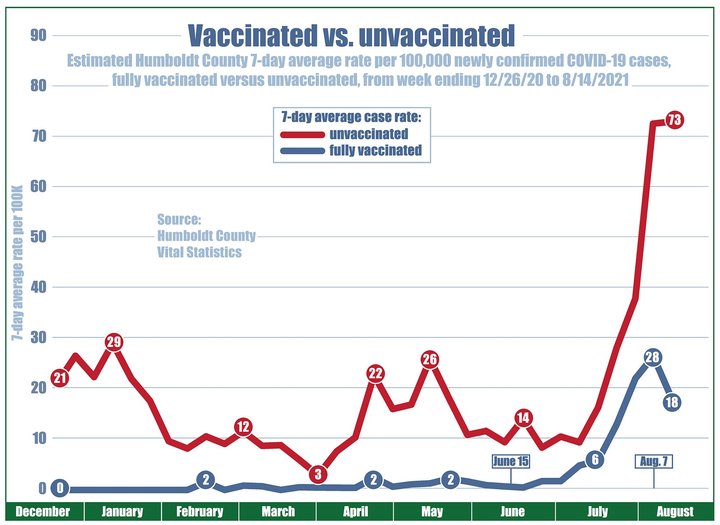
Humboldt County Health Officer Dr. Ian Hoffman. | Screenshot from Tuesday’s Board of Supervisors meeting.
###
Local hospitals have been inundated with new COVID-19 patients and health care workers are now under “severe distress and duress,” Humboldt County Health Officer Dr. Ian Hoffman told the Board of Supervisors on Tuesday.
“Many critically ill residents have been transferred out of the county due to lack of bed space in our local ICUs,” he said during his latest update on the pandemic. He went on to explain that the real problem isn’t a lack of beds so much as a lack of sufficient hospital staffing.
Plans to increase staffing levels at local hospitals were implemented weeks ago, but they haven’t really succeeded — largely, Hoffman suggested, because threadbare hospital staffing is a problem across the state and the nation.
“We actually just heard last night of our ability to secure some staff to increase the number of ICU beds, so that should really help,” he said.
Intensive care units have been at or near capacity for the past two weeks, with more than half the beds taken up by COVID patients. That has led hospitals to cancel surgical procedures deemed non-emergencies, though they may be seriously needed by community members — “things like heart surgeries, cancer surgeries [and] joint and back surgeries,” which could be delayed by weeks or months, Hoffman said.
Meanwhile, many of the COVID patients now taking up hospital beds are younger than we’ve seen to this point in the pandemic, “likely since this group has the lowest vaccination rate in our county,” Hoffman said.
Overall, there are signs that the county may be hitting a plateau — albeit a high one — in new cases.
“For the first time in over a month, the case count per 100,000 [residents] is not continuing to rise at dramatic rates week by week,” Hoffman said.

The county health officer called up the above graph, first published on Friday, which shows that the weekly case count among unvaccinated people in Humboldt County crested at 73 per 100,000 residents while the rate among the vaccinated fell to just 18 per 100,000. Roughly 90 percent of the people currently hospitalized with COVID-19 were unvaccinated, according to Hoffman.
That’s the first decline we’ve seen since the Delta-fueled surge began, and Hoffman noted that this dip coincides with the date of the renewed mask mandate, suggesting that people who’ve been following public health advice are seeing lower case rates.
County public health officials are echoing the message being consistently broadcast by their colleagues across the country, that vaccination for anyone 12 and older remains the best tool to prevent new infections and thereby keep schools and businesses open while reducing impacts to hospitals.
With the Food and Drug Administration’s full approval of the Pfizer-BioNTech COVID-19 vaccine on Monday, the county’s slow rate of new vaccinations may start to increase, Hoffman theorized. California recently implemented a vaccine mandate for health care workers and vaccine-or-regular-testing mandates for school staff and employees of state agencies.
Vaccine doses remain widely available but the county’s testing capacity has been strained during the latest surge.
“It’s expected that testing with rapid tests will need to expand in the coming weeks, both in businesses, schools and in healthcare [settings]” through a state-based testing partnership, Hoffman said.
Following the presentation, Second District Supervisor Michelle Bushnell asked whether kids in school really need to wear masks if they’re outside at recess. Hoffman said that if they’re able to maintain the recommended six feet of social distancing it’s not necessary, though he noted that most kids like to play together at recess. Bushnell countered that one school in SoHum has only 30 students total and eight per classroom, making distancing easy.
Fifth District Supervisor Steve Madrone said that while he believes vaccinations are “the way to go,” he thinks the county should broaden its approach in an effort to reach the vaccine-hesitant, possibly by embracing the use of monoclonal antibody treatment.
Hoffman noted that such treatment requires an infusion that takes several hours, plus monitoring, which requires both hospital space and staffing — both of which are in short supply. Providence-St. Joseph Hospital does have a plan to start implementing the treatment, which has proved to be effective in treating early stages of the virus, but the labor-intensive treatments work best for people who have mild symptoms or no symptoms and have yet to be admitted to the hospital, Hoffman said.
Fourth District Supervisor and Board Chair Virginia Bass said irresponsible people — meaning the unvaxxed and/or unmasked — are “unwittingly harming small businesses” by exposing employees to infection. And as for the Humboldt County Fair, which was held despite the recent surge in cases, Bass said, “Personally I was not going anywhere near the fair. I think that was the worst idea.”
First District Supervisor Rex Bohn said the current hospitalization and case numbers are “appalling,” and he pushed back against the frequent claim that the only people who COVID kills are those who were already sick and old. “These were people who were alive and now aren’t, and the main factor was COVID,” he said.
Third District Supervisor Mike Wilson said he was disturbed to learn that locals have fallen for claims that COVID can be treated with ivermectin, a drug often used to deworm livestock.
As if to prove his point, a local man called in during the public comment period to complain that people are having to resort to buying ivermectin at farm supply stores because government officials are getting paid off to promote the vaccine. Another falsely claimed that 1,200 people have died from the vaccine and testing is not effective.
A third caller expressed frustration with such unfounded statements. “The disinformation people are hurting us, hurting our community,” she said. “We need to treat it like the serious problem it is.”
You are not a horse. You are not a cow. Seriously, y’all. Stop it. https://t.co/TWb75xYEY4
— U.S. FDA (@US_FDA) August 21, 2021
CLICK TO MANAGE